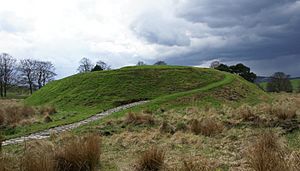Peel of Lumphanan facts for kids
The Peel of Lumphanan is an old defensive structure, like a mini-castle. It was built way back in the 1200s. You can find it in north-east Scotland, near a place called Lumphanan in Aberdeenshire. It's also known as the Peel Ring or Peel Bog of Lumphanan.
Contents
What is the Peel of Lumphanan?
The Peel of Lumphanan is made up of a large mound, or "motte." This motte is surrounded by two circular ditches, like rings. There's also a raised area of earth between these two ditches.
The outer earth bank is about 4 meters (13 feet) high. The inner ditch, which was like a moat filled with water, is 15 meters (49 feet) wide. The main hill itself is about 37 by 45 meters (121 by 148 feet) across.
On top of the main mound, you can still see the remains of a thick wall. This wall was about 1 meter (3 feet) thick. There are also foundations of an old house, which was about 15 by 4 meters (49 by 13 feet) in size. The main entrance to the peel was probably on the west side. The bottom part of the motte was a natural hill. Builders made it taller when they built the castle.
A Link to King Macbeth
A motte might have been here even before the current structure. This earlier motte would have been present around the time of the Battle of Lumphanan. This famous battle happened nearby in 1057. It was fought between King Macbeth and the future King Malcolm III.
King Macbeth was killed during this battle. A special stone, called Macbeth's Stone, is located about 300 meters (984 feet) to the south-west. People say this is where Macbeth was executed.
Who Built the Peel?
The current mound was built in the 13th century, which is the 1200s. It was built by the De Lundin family. This family later changed their name to Durward. They got the name "Durward" because they had a special job. They were the royal "door-wards," or ushers, for the king. This job was passed down through their family.
The Durwards used the Peel of Lumphanan as a lodge. It was a place where they could stay when they went hunting. Their main home in the area was Coull Castle.
In 1296, a knight named Sir John de Melville visited the peel. He paid his respects to Edward I of England there. The first walls of the peel might have been made of earth and grass, not stone.
The rectangular foundations you see today are from a house called Halton House. This house was built in the 15th century (the 1400s) by Thomas Charteris of Kinfauns. For a long time, people thought a circular wall on the site was part of a "shell keep." A shell keep is a type of castle wall. But during digs in the 1970s, they found out this circular wall was actually built much later, in the 18th century (the 1700s).
Protecting the Peel
Today, the Peel of Lumphanan is looked after by Historic Scotland. It is protected as a "scheduled monument." This means it's a very important historical site. Experts believe it's important because it's a good example of an old earthwork castle. It still has its outer defenses, which were once filled with water.


